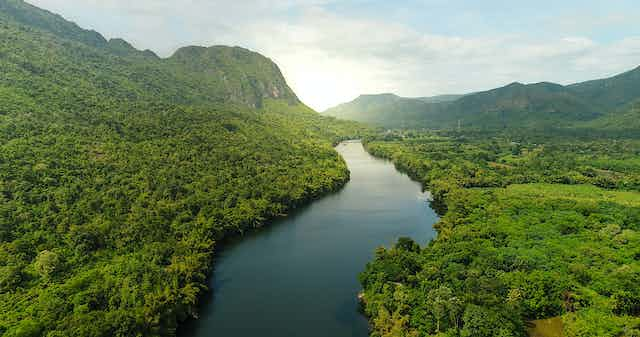The world is falling behind on commitments to protect and restore forests, according to the recent Forest Declaration Assessment. There is no serious pathway to fixing climate change while forest losses continue at current rates, because global climate targets, sustainable development goals and forest commitments depend on each other.
But it isn`t too late. The Assessment was published alongside the Forest Pathways Report I led for conservation organisation the WWF, which sets out a blueprint for how we turn our global forest failures around and get on track to protected, restored and sustainably managed forests.
Around 1.6 billion people live close enough to forests to depend upon them for their livelihoods, and forests suck down about a third of our CO₂ emissions from fossil fuels.
The United Nations estimates that forests generate $250 billion (£206 billion) of economic activity annually. Its widespread indirect value could reach $150 trillion (£12 trillion) a year, twice the value of global equities, largely due to its ability to sequester carbon.
However, subsidies remain an incentive to convert forests to agriculture.Lost Promises
There have been several global commitments to forests, with hundreds of governments and companies making pledges named after cities, including Bonn in 2011, New York in 2014, and Glasgow in 2021. signed the document.
However, these promises have not been fulfilled. , and targets to reduce deforestation are falling short year by year.Global forest loss in 2022 will be 6.6 million hectares, an area roughly the size of Ireland. This is 21% more than the amount agreed in Glasgow to achieve zero deforestation by 2030.
Rainforest losses are even more significant, exceeding the target by 33%. Deforestation in 2022 retreated by 4% from 2021 progress.
Why we can’t protect our forest
There is no simple explanation why forests continue to be lost. Contributing factors include indigenous peoples’ lack of rights to their territories, financial and trade systems that damage forests, and the physical effects of climate change and fire.
The lack of consistent and secure land tenure for indigenous peoples and local communities threatens forests and the peoples who depend on them. The evidence is clear that deforestation and degradation are lower in the tropics where forests are managed.
Subsidies that can lead to deforestation are worth between $381bn (£314bn) and $1trn (£825bn) a year. This includes handing over public lands to settlers, building roads and pipes for industrial agriculture, artificially low taxes on agricultural products, or subsidies for certain crops on previously forested lands. This may include providing money.
There are also illegal activities. According to recent estimates, 69% of tropical forests cleared for agriculture between 2013 and 2019 violated national laws and regulations. The worldwide illegal timber trade is estimated to be worth $150 billion annually.
There is not enough money to support forests. Public financing for forests accounts for less than 1% of investments in activities that are harmful to the environment or encourage deforestation.
Forests around the world are also being harmed by climate change and changing wildfire patterns. Climate change is causing more fires, including in forests that don’t normally burn, increasing fire temperatures and causing long-term damage even in fire-adapted forests.
Droughts are increasing in duration and severity, causing water scarcity and tree death. A combination of climate-related stresses is causing trees in tropical, temperate, and boreal forests to die younger and large-scale diebacks to occur more frequently.
If the effects of fire and climate change continue, post-Anthropocene forests are likely to be smaller, have fewer species, lack wildlife, and be confined to steeper landscapes less favorable to agriculture. expensive.
Computer simulations of future climate, called climate models, show very different outcomes for forests, depending on whether we limit global warming. If emissions are curbed and some cultivated land is left to nature, 350 million hectares of forest could be re-forested by 2100.
This is an area roughly the size of India. But in the future, where emissions remain high and land use remains unchanged, models suggest an additional 500 million hectares of forest will be lost by 2100.
Back on track
The new Forest Pathways Report I worked on sets out an action plan for getting back on track. It asks global leaders and businesses to:
Accelerate the recognition of Indigenous Peoples and local communities` right to own and manage their lands, territories and resources.
Provide more money, both public and private, to support sustainable forest economies.
Reform the rules of global trade that harm forests, getting deforesting commodities out of global supply chains, and removing barriers to forest-friendly goods.
Shift towards nature-based and bio economies
The upcoming COP28 climate summit in Dubai will see bilateral announcements between wealthy donors and tropical forest nations as part of the Forest and Climate Leaders’ Partnership signed in Glasgow two years ago. It’s promised. These packages have the potential to support a step towards sustainable forest management and deforestation-free supply chains around the world.
While this would be a valuable achievement, leadership is urgently needed on other issues such as environmentally damaging subsidies and illegal logging, the scale of which dwarfs the resources allocated to forest protection. That’s about it.
